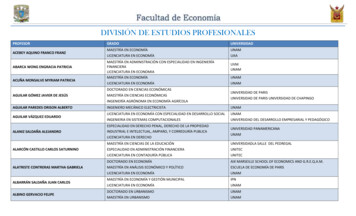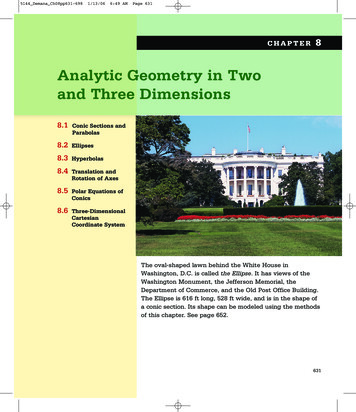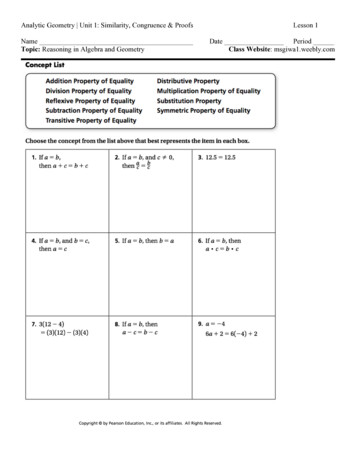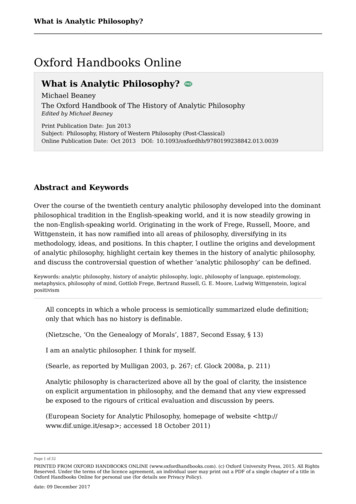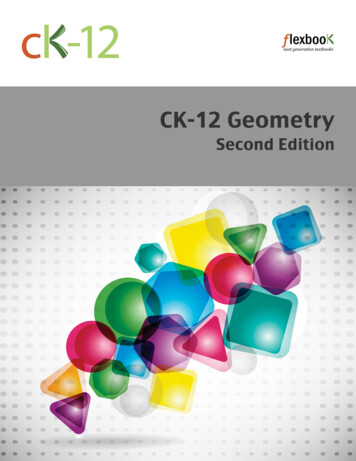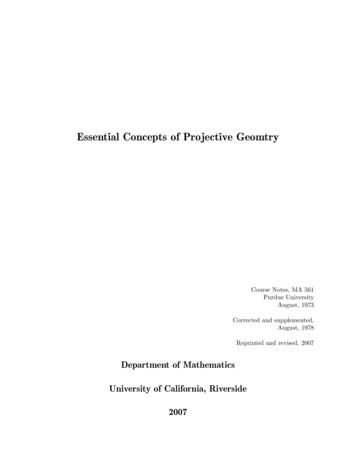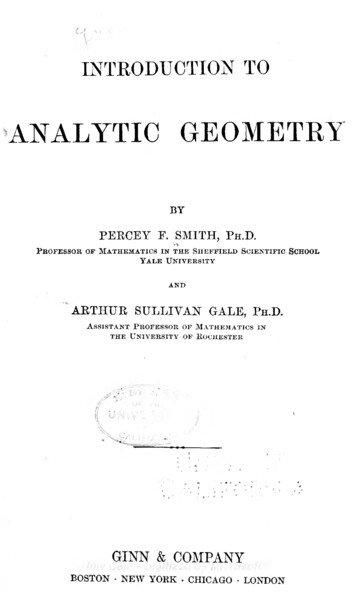
Transcription
INTRODUCTION TOANALYTIC GEOMETRYBYPEECEY R SMITH,PH.D.NPROFESSOR OF MATHEMATICS IN THE SHEFFIELD SCIENTIFIC SCHOOLYALE UNIVERSITYANDAKTHUB SULLIVANGALE, PH.D.ASSISTANT PROFESSOR OF MATHEMATICS INTHE UNIVERSITY OF ROCHESTERGINN & COMPANYBOSTONNEW YORK CHICAGO LONDON
COPYRIGHT,1904, 1905,BYARTHUR SULLIVAN GALEALL BIGHTS RESERVED65.8GINN & COMPANYPRIETORSBOSTONPROU.S.A.
PEE FACEIn preparing this volume the authors have endeavored to writea drill book for beginners which presents, in a manner conforming with modern ideas, the fundamental concepts of the subject.The subject-matterismore than the minimum requiredmuch more as is necessary to permitslightlyfor the calculus, but only asofsome choice on the part of the teacher.textisIt is believed that thecomplete for students finishing their study of mathematicswith a course in Analytic Geometry.The authors haveform of atreatiseintentionally avoided giving the book theon conicsections.Conic sections naturallyappear, but chiefly as illustrative of general analytic methods.Attentioniscalled to themethod of treatment.Thesubjectisdeveloped after the Euclidean method of definition and theorem,without, however, adhering to formal presentation.tageisobvious, for the student isof each acquisition.examples areThisisworked outThe advan-sure of the exact natureAgain, each methodstated in consecutive steps.illustrativemadeissummarized in a rulea gain in clearness.Emphasis has everywhere been put upon the analyticis, the student is taught to start from the equation.thatshown howtoto use it inany other way.work with theManyin the text.figure as a guide, but isChapter IIImayside,Heiswarned notbe referred to inthis connection.Theetryisobject of thetwo short chapters on Solid Analytic Geom-merely to acquaint the student with coordinates in spaceiii20206fi
PREFACEivand with therelationsbetween surfaces, curves, and equations inthree variables.Acknowledgments are due to Dr. W. A. Granville for manyhelpful suggestions, and to Professor E. H. Lockwood for suggestions regardingNEWsome of the drawings.HAVEN, CONNECTICUTJanuary, 1905
CONTENTSCHAPTERIREVIEW OF ALGEBRA AND .Special quadratics5.Cases6.Variables7.Equations in several variablesFunctions of an angle in a right triangle8.quadratic.whenTypical form.5.99.11.12.Rules for signs13.Greek alphabet10.124the roots of a quadratic are not independentAngles in generalFormulas and theorems from TrigonometryNatural values of trigonometric functions9.1.".1111.12.141515CHAPTERIICARTESIAN COORDINATES14.Directed line1615.Cartesian coordinates1716.Rectangular coordinates1817.Angles2118.Orthogonal projection2219.Lengths20.Inclination24and slope2721.Point of division3122.Areas3523.Second theorem of projection.40
CONTENTSviCHAPTERIIITHE CURVE AND THE EQUATIONSECTIONPAGE24.Locus of a point satisfying a given condition25.26.Equation of the locus of a point satisfying a given conditionFirst fundamental problem27.General equations of the straight line and28.Locus of an equation Second fundamental problem29.44circle.44.46.50.52.30. Principle of31.comparisonThird fundamental problem.32.Symmetry33.Further discussion34.Directions for discussing an equation35.Points of intersection36.Transcendental curvesDiscussion of an equation.5560.53.6566.6769t72CHAPTER IVTHE STRAIGHT LINE AND THE GENERAL EQUATION OF THE FIRST DEGREE37. Introduction.7639.The degree of the equation of a straight lineThe general equation of the first degree, Ax40.Geometric interpretation of the solution of two equations of the38.first-fBy C 76.80degreedetermined by two conditions42. The equation of the straight line in terms of its slope and the coordinates of any point on the line41. Straight lines43.44.45.46.47.The equation 91 the straight line in terms of its interceptsThe equation/of the straight line passing through two given pointsThe normal form of the equation of the straight line.The distance from a line to a pointThe angle which a line makes with a secondlineThe system of lines parallel to a given lineThe system of lines perpendicular to a given lineThe system of lines passing through the ms of straight49.61.48.50.77of.108two givenHO
CONTENTSviiCHAPTER VTHE CIRCLE AND THE EQUATIONSECTION52.The53.Circles determined54.general equation of the circleSystemsa; 2 y 2 Dx Ey F PAGE.115116by three conditions120of circlesCHAPTER VIPOLAR COORDINATES12555.Polar coordinates56.67.Locus of an equationTransformation from rectangular to polar coordinates58.Applications13259.Equation of a locus133CHAPTER126.130VIITRANSFORMATION OF COORDINATES60. Introduction61.136.136Translation of the axes62. Rotation of the axes.63.General transformation of coordinates64.Classification of loci-65.Simplification of equations66. Application to138.139140by transformation of coordinatesequations of the first and second degrees.CHAPTER141144.VIIICONIC SECTIONS AND EQUATIONS OF THE SECOND DEGREE.68.Equation in polar coordinatesTransformation to rectangular coordinates69.Simplification and discussion70.Simplification and discussion of the equation in rectangular coordinates. Central conies, e 171.Conjugate hyperbolas and asymptotes72.The67.nates.Theparabola, e 1.149154of the equation in rectangular coordi.equilateral hyperbola referred to.:.154.158165.itsasymptotes.167
CONTENTSviiiPAGESECTION74.Focal property of central coniesMechanical construction of conies75.Types of73.168.76.loci of equations of the second degreeConstruction of the locus of an equation of the second degree77.Systems of conies168170173.176CHAPTER IXTANGENTS AND NORMALS.Theslope of the tangentEquations of tangents and normals80. Equations of tangents and normals to the conic sections78.18018279.81.82.y83.Tangents to a curve from a point not on the curveProperties of tangents and normals to conies.Tangent184.186188in terms of its slope192CHAPTER XCARTESIAN COORDINATES IN SPACE19684. Cartesian coordinates85.198LengthsOrthogonal projections.CHAPTER XISURFACES, CURVES, AND EQUATIONS86. Loci in space87. Equation of a surface.201First fundamental90.problemEquations of a curve. First fundamental problemLocus of one equation. Second fundamental problemLocus of two equations. Second fundamental problem91.Discussion88.89.the.curve.Third fundamentalequation of a surface.Third fundamentalequations ofa206problem92. Discussionof the207problem205205.201202.of.93.Plane and straight line94.The sphere95.Cylinders96.Cones97.Non-degenerate quadrics210211.213.214.215
UNIVERSITY',OFANALYTIC GEOMETRYCHAPTERIREVIEW OF ALGEBRA AND TRIGONOMETRY1.Numbers. The numbers arising in carrying out the operatwo kinds, real and imaginary.real number is a number whose square is a positive number.tions of Algebra are ofAZero alsoisa real number.A puretiveimaginary number is a number whose square is a neganumber. Every such number reduces to the square root ofa negative number, and hence has the form bV1, where b is a2andnumber,(V I)An imaginary or complex number is a number which may bewritten in the form a b1, where a and b are real numbers,and b is not zero. Evidently the square of an imaginary numberis in general also an imaginary number, since 1.realV b V T) 2(awhich2.isimaginaryConstants.Aifaisa2- b 2 ab V l,2not equal to zero.quantity whose value remains unchangediscalled a constant.Numerical or absolute constants retain the same values inproblems, as2,3,Vl,allTT, etc.Arbitrary constants, or parameters, are constants to which anyone of an unlimited set of numerical values may be assigned, andthese assigned values are retained throughout the investigation.Arbitrary constants are denoted by letters, usually by letters from thepart of the alphabet. In order to increase the number of symbols at ourfirst1
ANALYTIC GEOMETRY2itdisposal,exampleisconvenient to use primes (accents) or subscripts or both.For:Using primes,"a prime or afirst"), of' (read "a double prime or a second"),third"), are all different constants.a' (reada'" (read"aUsing subscripts,&!(read"6"one"), 6 a (read 6 two"), are different constants.Using both,c/(read "c one prime"),c8"(read"cthree double prime"), are differentconstants.3.Thequadratic.Typical form.Anyquadratic equationin themay by transposing and collecting the terms be writtenTypicalFormAx 2 Bx(1) C 0,in which the unknown is denoted by x. The coefficients A, B, Care arbitrary constants, and may have any values whatever,except that A cannot equal zero, since in that case the equationwould be no longer of the second degree. C is called the con-stant term.The left-hand memberAx*(2) Bx Ccalled a quadratic, and any quadratic may be written in thisTypical Form, in which the letter x represents the unknown.4 A C is called the discriminant of either (1)The quantity B 2isor (2), andThatis,isdenoted by A.the discriminantAof a quadratic or quadratic equa-tion in the Typical Form is equal to the square of the coefficientof the first power of the unknown diminished by four times theproduct of the coefficient of the second power of the unknownby the constant term.The roots of a quadratic are those numbers which make thequadratic equal to zero when substituted for the unknown.The roots of the quadratic (2) are also said to be roots of thequadratic equation(1).to satisfy that equation.Aroot of a quadratic equationissaid
REVIEW OF ALGEBRA AND TRIGONOMETRYIn Algebrashown thatit is(2) or (1)has two roots, Xi andobtained by solving (1), namely,(3)Adding thesevalues,we havex(4)-f-B x Vw*\&Multiplying givesXiX z(5) 'AHenceTheoremI.T e sum of the roots of a quadratic is equal to thepower of the unknown with its sign changedcoefficient of the firstdivided by the coefficient of th& second power.The product of the roots equals the constant term divided by thecoefficient of the second power.The quadratic Ax*(6)as(2)maymay be written in the formBx C *A(x - x,} (x - * 2),be readilymember andshown by multiplying out the right-handsubstituting from (4) and (5).For example, since the roots of 3 a; 2tically 332-43 1 3*(x - 1) (x -The character of the4 a; 1 are 1 and,w haveiden-*).roots x land x z as numbers(1)whentheCare real numbers evidently depends entirelyA, B,thediscriminant.This dependence is stated inuponcoefficientsTheoremandII.If thecoefficientsof a quadratic are real numbers,if the discriminant be denoted by A, then4/i*Thewhen Awhen Awhen A isisispositive the roots are real and unequal;zero the roots are real and equal ;negative the roots are imaginary.is read "is identical with," and means that the two expressionssignconnected by this sign differ only inform.
ANALYTIC GEOMETRY4In the three cases distinguished by Theorem II the quadraticmay be written in three forms in which only real numbers appear.These are'C A (xXi) (x x z ), from (6), if A is positive ;Ax 2 Bx C A(xx ) 2 from (6), if A is zero ;Ax 2 Bx-f-1,AC-B\2Ax* Bx CB A\[-/(* o r)Theproved thuslast identity isadding and subtracting4.C2 A )L\L-H2 ]Y if7-7* AJ is negative.:within the parenthesis.If one or both of the coefficientsSpecial quadratics.Bandin (1), p. 2, is zero, the quadratic is said to be special.CASECI.Equation (1)(1)0.now becomes, by factoring,Ax z Bx x(Ax B) 0.r Hence theroots area quadratic equationis zero.Andstant termisx1 0,x2 Therefore one root ofylzero if the constant term of that equationis a root of a quadratic, the con-conversely, if zeromust disappear. Forwe have C 0.ifx satisfies (1), p. 2,substitutionCASEII.EquationB (1), p. 2,(2)From Theorem(3)0.now becomesAx 2I, p. 3,x C -f x 20.0,that! -*is,by
REVIEW OF ALGEBRA AND TRIGONOMETRYifTherefore,the coefficient of thein a quadratic equationbut have opposite signs.first5power of the unknownthe roots are equal numericallyConversely, if the roots of a quadraticis zero,equation are numerically equal but opposite in sign, then thecoefficient of the first power of the unknown must disappear. For,sumsince theB of the rootsis zero,CASEB C III.Equationhave, byTheoremI,(1), p. 2,0.now becomesAx 2 (4)Hence thealways0.roots are both equal to zero, since this equation0, the coefficient A bei ng, by hypothesis,that x 2requires5.we must0. vdifferentCaseswhenfromzero.the roots of a quadratic are not independent.between the roots Xi and x z of the TypicalIf a relation exists:FormAx 9 Ex C 0,then this relation imposes a condition upon the coefficients A,B, and C, which is expressed by an equation involving theseconstants.B2For example, if the roots are equal, that-4: AC 0, by Theorem II, p. 3.Again, if one root is zero, then x& 2 Theoremp.I,is,;if Xihence xC2,then 0,by3.This correspondencemaybe stated in parallel columns thusQuadratic in TypicalRelation between theroots:FormEquation of conditionby thesatisfiedcoefficientsIn many problems the coefficients involve one or more arbitraryconstants, and it is often required to find the equation of condi-by the latter when a given relation exists betweenSeveral examples of this kind will now be worked out.tion satisfiedthe roots.
ANALYTIC GEOMETRY6Ex.1.What mustbe the value of the parameter kifzero-6z 2 -3fc-4 0?B - 6, C k' - 3 k - 4. ByCaseisa root ofthe equation2x2(1)Solution.isHereA 2,fc2C a root when, and only when,Ex.zeroor1.For what values of k are the roots of the equation2.kx 2real 4kSolving,I, p. 4,0.and equalSolution. 2kx-4x 2-3k?Writing the equation in the Typical Form, we have fcx2(2)-k(2 4)x(3k-2) 0.Hence, in this case,A k, B 2k-4, C 3k-2.Calculating the discriminant A,A (2k- 8fc2By TheoremA II, p. 3,-24)we4kgetk - 2) -8(A:2 (3-8A;-f 16&- 2).the roots are real and equal when, and only when,'k*.-.k Solving, -k2 or2 0.Ans.1.Verifying by substituting these answers in the given equationwhen fc -2,when fc 1,(2)becomes(2)becomesthe equationthe equation" Hence, for these values offormed as in Ex.a 6,3.fc,x2the left-handfc,2 1 0,member:or -2(x-f 2) 2 0;or(x1)may beof (2)m(3)trans-equation of condition must be satisfied by the constantsthe roots of the equationif(62 a2 m 2) y2 a2fc22a? kmya2 &2 Qare equal ?Solution.2 0.(7), p. 4.Whatand2x2 -8x-8 0,(2)The equationalready in the Typical(3) isForm;henceA 6 a m B 2 a km, C a?k2 - a 62222 2.2,By TheoremII, p. 3,A the discriminant4 a4 fc2m2 - 4 (62 A musta2 m 2 ) (a2 &2vanish-a2 62 )Multiplying out and reducing,a2 &2 (fc 2-a2 m 2-62 ) 0.Ans.;hence 0.
REVIEW OF ALGEBRA AND TRIGONOMETRYEx.7For what values of k do the common solutions of the simultaneous4.equations3x 4y (4)x2(5)become y2fc, 25identical ?Solution.(4) for y,Solvingwe have t(*-3x),y(6)and arrangingSubstituting in (5)25 x(7)Let the roots of2-6 kx k*be x\ and x 2(7)corresponding values y\ and y z of yi(8)and weshallhave twoin the TypicalThen.y,Formgives- 400 0.substituting in (6) will give thenamely,i(&commonsolutionsand(xi, y\)y2 )(x 2 ,of (4)and(5).But, by the condition of the problem, these solutions must be identical.Hence we must have xi(9)If,however, thebe equal.firstX 2 and y lof theseis true (xiy2. x2 ),then from(8) y\and y will alsoTherefore the twoand only when,criminantAcommonof (7) vanishes.-.Solving,Verification.solutions of (4)andbecome identical when-,(5)the roots of the equation (7) are equal; that(Theoremis,whenA;Substituting each value of k in(7),when A; 25, the equation (7) becomes x 6x 9 0, or (x 3) 2 0when k -25, the equation (7) becomes x2 6x 9 0, or (x-f 3) 2 0;;(6),3,25 and x3,Therefore the twocommonwhen k of these values ofifkifk .x 3.-.x ;3.substituting corresponding values of k and x,25 and xwhen kdis-.36 2 - 100 (fc* - 400) 0. A*625,25.Ans.k 25 orA 2Then fromtheII, p. 3).fc,we have y (25 9) 4;we have y ( 25 -f 9) solutions of (4)and(5)4.are identical for eachnamely,25, the26, thecommoncommonsolutions reduce to xsolutions reduce to x 3, 43, y y;4.Q.E.D.
ANALYTIC GEOMETRY8PROBLEMS1.Calculate the discriminant of each of the following quadratics, deterof the roots, and write eachmine the sum, the product, and the characterquadratic in one of the forms (7), p. 4.2x2 6x 4.x2 - 9x - 10.1 - x - x2(a)(b)(e).(c)2.(d)For what(f)2k - 3x2 6x - &2 (b)3.For what(a)(c)(d)5x2 - 3x 0.(f)(g)Ans. kAns. k l. - I or 3.Verify your answers.Ans. kAns. kAns. k0. -f 6. -.Ans. None.Ans. k &.Ans. None.Ans. k - . 0.x2 -f kx k2 2 0.x2 - 2 kx - k - I 0.(e)4.0.-3x-l 0.x2 - kx 9 0.2 kx2 3 kx 12 2 x2 kx - 1 0.(b)3real values of the parameter are the roots of the followingequations equal ?fcx 2parameter k will one root of each of thereal values of thefollowing equations be zero ?.2- 3 k2 3 (a) 6x ' 5 kx4x2 - 4x 1.5x2 lOx 5.3x2 - 5x - 22.5fc2Derive the equation of condition in order that the roots of the followingmay be equal.equations(a)m x 2 kmx - 2px - k2(b)x22(c)5.2Ans. p (p - 2 km) 0.Ans. p (m 2p - 2 6) 0.Ans. fr2 2 a 2 m. 2 mpx 2 6p 0.2 mx 2 2 bx a2 0.For whatreal values of theparameter do thecommonsolutions of thefollowing pairs of simultaneous equations become identical ? k, x2 y2 5.-4ns. k (a) x 2 y(b)(c)(d)(e)(f)(g)(h) mx 1, x2 4 y.2 x - 3y 6, x 2 2 x 3 y.y mx 10, x2 y2 10.Ix y - 2 0, x2 - 8 y 0.x 4 y c, x2 2 y 2 9.2 y 0, x 2 y c.a2 y 2 - xx2 4 y 28 x 0, mx - y - 2 m 0.y6. If theare to(a)(b)(c)Ans.-4ns.Ans.5.m 1. 0.m 3.6Ans. None. .ns.cAns.c .ris.None.9.or5.common solutions of the following pairs of simultaneous equationsbecomeidentical,whatisthe corresponding equation of condition ay a&, y2 2px. mx 6, .Ax2 .By 0.yy m(x- a), By 2 Dx 0.bx.? ap) 0.B (mzB - 4 bA) 2- D) D(4 amAns. ap (2 62 Ins.-Ans.0.0.
REVIEW OF ALGEBRA AND TRIGONOMETRY6.AVariables.variableisa quantity to which.jrijjfrinvestigation, an unlimited number of values can be assigned.In a particular problem the variable may, in general, assume anyvalue within certain limits imposed by the nature of th problem It is convenient to indicate these limits by inequalities.For example, if the variable x can assume any value between2 and 5, thatx must be greater* than2 and less than 5, the simultaneous inequalitiesis, if* -2, x 5,are written in the more compact form-2 z 5.Similarly, if the conditions of the problem limit the values of the variable x toany negative number less than or equal'to2, and to any positive number greaterthan or equal to5,the conditions2 OT x x x are abbreviated to2,and x 5 or x 52 and x 5.Write inequalities to express that the variableto 5 inclusive.(a) x has any value from2 or greater than1.(b) y has any value less than8 nor greater than(c) x has any value not less than7.2.In Analytic GeometryEquations in several variables.weare concerned chiefly with equations in two or more variables.An equation is said to be satisfied by any given set of valuesof the variables if the equation reduces to a numericalequalitythese values are substituted for the variables.whenFor example, x y2, 3 satisfy the equation 32,2 35, 3(- 3)2 35.2x2since2(2)2Similarly, x 1,y 0, z 4 satisfy the equation2z2 3 y 2 2;2 i 8 since2(1)23X (4)218o, 0.*The meaning of greater and less for real numbers ( 1) is defined as follows a iswhen a - b is a positive number, and a is less than b when a - b is negative.Hence any negative number is less than any positive number and if a and b are bothnegative, then a is greater than b when the numerical value of a is less than the numer:greater than b;icalvalue of6.Thus 3 5, but - 3 - 5.the inequality sign.Therefore changing signs throughout an inequality reverses
ANALYTIC GEOMETRY10Anequationsaid to be algebraic inisany number of variables,can be transformed into an equationexampleeach of whose members is a sum of terms of the form ax my n z p,forx, y, 2, if itwhere aisa constant and m, n, p are positive integers or zero.Thus the equationsx* x 2y 2 -z 2a:5 0,are algebraic.The equationisx* y* a?algebraic.For, squaring,weget 2 x y* y a.2 x*y* axa2 x 2 yz2 axxTransposing,Squaring,4 xyTransposing,x2The y22 ax2 xy2 ayy. 2 xy. a2 0.2 ayQ.E.D.an algebraic 'equation is equal to the highestofAn algebraic equation is said toits terms.*anywithtothevariables when all its terms areIbe arrangedrespectdegree ofdegree oftransposed to the left-hand side and written in the order ofdescending degrees.For example, to arrange the equation2x' 2 3y' 6x'-2x'y'-2 z/3 x'*if - y'*with respect to the variables z', y',x '3This equationyfvtf 2 Xis'2wetranspose and rewrite the terms in the order2x'y' y'2 6a/ 3y'2 0.of the third degree.An equation whichisnot algebraicissaid to be transcendental.Examples of transcendental equations arey sinx,y 2*, logy 3x.PROBLEMSthe1. Show that each of the following equations is algebraic; arrangeterms according to the variables x, y, or x, y, z, and determine the degree.(e)*The degreeofy 2 Vx2 -2x-5.any termisthesumof the exponents of the variables in that term,
REVIEW OF ALGEBRA AND TRIGONOMETRY y . x(f)611 V2x2 -6xW* - j y(h)2.Show ix B Vix'J 4- JMTx N.*homogeneous quadraticthat theAx2 Bxy Cy*may be written in one of the three forms below analogous to24satisfies the condition giventhe discriminant A BCASECASEII.CASEIII.I.ACAx Bxy Cy A(x- hy] (x - y),.Ax 2 Bxy Cy 2 A(x- ky) 2 if A 1x2 Bxy Cy* A 22I2,(7), p. 4,if:ifA ;;', ifA 0.[(xFunctions of an angle in a right triangle. In any righttriangle one of whose acute angles is A, the functions of A are8.defined as followssin:oppositeA -**sideA (/,/escA -secadjacent side- -*,hypotenuseAadjacent side'hypotenuseopposite sidetan A adjacent sideFromcotthe above the theoremB opposite side'hypotenusecoshypotenuse.4J adjacenteasily derivedisside -.opposite side:In a right triangle a side is equal to theproduct of the hypotenuse and the sine of theangle opposite to that side, or of the hypotenuse and the cosine of the angle adjacent tothat side.ACban angleXOA9.consideredisOAerated by the y rotating fromThe angle isposition OX.when OA rotates from erotationofwhenOA sclockwise.*Thecoefficients A, B,Cand the numbersfj, I 2are supposed real.
ANALYTIC GEOMETRY12Thefixed lineterminalOXis calledthe initial line, the lineOAtheline.Measurement of angles. There are two importantof measuring angular magnitude, that is, there aremethodstwo unitangles.Degree measure. The unit angletion, and is called a degree.is J of a complete revolu-The unit angle is an angle whose subtendequal to the radius of that arc, and is called a radian.fundamental relation between the unit angles is given byCircular measure.ing arcTheisthe equation IT radians180 degreesOralso,by solving(IT 3.14159).this,1 degree 1 radian loU801.0174radians, 57.29degrees.7TThese equations enable us to change from one measurement toIn the higher mathematics circular measure is alwaysanother.used, and will be adopted in this book.The generating line is conceived of as rotating around throughasmanyAnyrealconversely,10.werevolutions asnumberisany angleisHence the importantchoose.resultthe circular measure of some angle,measured by a real number.Formulas and theorems from Trigonometry.1.cotx tanx2.tanx sinx;secx;cotxcosx4.;cscx smx cosxsin xcosx3. cos2 x 1 1 tan2 x sec2 x 1 cot2 x csca z.esc xsin (- x) - sin x esc (- x) secx;cosx;x)sec(x)cos(cotx.tan(- x) tanx cot (- x) sin2x;;;;;:and
REVIEW OF ALGEBRA AND TRIGONOMETRY5.13- x) sinx sin (?r x) - sinx- x) - cosxcosjtf . &. - ?osxjtanx jftan (ie x) tanxtan (itx) sin(if;cos (x;;;6.-x)sin(- cosx;sin( cos(--x) sinx; cos sin (2Tt8.sin (x 9.sin (xx) sin ( x)cosx; x) - sinx; x) - cotx.tanf-tan(- -x) cotx;7. x) Osin x, etc.oy) sinx cosy cos x siny) sin x cos ycos x sin y.10. cos (x y} cos x cos ysin x sin y.11. cos(xy) cos x cosy sinx sin y.12tan (x14. sin 2 x y)-- tan y tanxI - tanx tany 2 sin x cos x;cos 2 xy.- y) tanxtany tanx tany.13. tan (x sin 2cos 2 xx;1tan 2 x 2 tanxx cosx tan- ;16.Theorem.LawIn any triangle the sides are proportionalof sines.to the sines of the opposite angles;abcLqw of cosines. In any triangle the square of a sideof the squares of the two other sides diminished by twice theproduct of those sides by the cosine of their included angle ;17.Theorem.equals thethatsuma2is,18.Theorem. 62 c22 be cos A.Area of a triangle. The area of any triangle equals onetwo sides by the sine of their included anglehalf the product ofthatis,area; ab sinC ibe sinA ca sin B.
ANALYTIC GEOMETRY1411.Natural values of trigonometric functions.Angle inRadians
REVIEW OF ALGEBRA AND TRIGONOMETRYAngle inRadians15
introductionto analyticgeometry by peeceyrsmith,ph.d. n professorofmathematicsinthesheffieldscient
